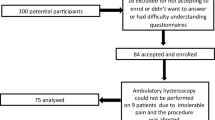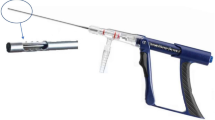Abstract
Background
Mini-hysteroscopy is believed to be pain-free or in the least bearable. Office procedures are therefore usually performed without analgesia or anesthesia. Is it indeed as tolerable as papers and authors suggest?
Objectives
To estimate what proportion of women reports moderate to severe discomfort during examination using the smaller diameter scopes.
Search strategy
Online sources were search with key words “hysteroscopy” and “pain” from 2000 to December 2014. Thirty-five articles were retrieved for detailed analysis.
Selection criteria
Randomized controlled trials (RCT) and well-designed prospective trials (PT) studying pain as main outcome, in office mini-hysteroscopy in at least one arm. Studies or arms within a study where conscientious sedation, anesthesia, or non-steroidal drugs were used were excluded. Chosen data collected was the number of women referring moderate to severe pain compared to total women with intervention in the arm or study. Authors were contacted to try to retrieve unpublished data for analysis.
Data collection and analysis
We performed a meta-analysis from eight studies (six RCT and two PT) comparing pain reported as moderate or severe to total women in mini-hysteroscopy.
Main results
A meta-analysis estimated the pooled prevalence of pain (>3–10 on 10 cm visual analog scale) for all studies and by two subgroups: (1) RCT and (2) PT. Due to significant heterogeneity between studies, we used the random effects model. Results revealed a high prevalence of pain in outpatient mini-hysteroscopy.
Conclusions
Office mini-hysteroscopy is painful.



Similar content being viewed by others
References
Guida M, Di Spiezio Sardo A, Acunzo G, Sparice S, Bramante S, Piccoli R, Bifulco G, Cirillo D, Pellicano M, Nappi C (2006) Vaginoscopic versus traditional office hysteroscopy: a randomized controlled study. Hum Reprod 21(12):3253–3257. doi:10.1093/humrep/del298
Siristatidis C, Chrelias C (2011) Feasibility of office hysteroscopy through the “see and treat technique” in private practice: a prospective observational study. Arch Gynecol Obstet 283(4):819–823. doi:10.1007/s00404-010-1431-3
Dealberti D, Riboni F, Prigione S, Pisani C, Rovetta E, Montella F, Garuti G (2013) New mini-resectoscope: analysis of preliminary quality results in outpatient hysteroscopic polypectomy. Arch Gynecol Obstet 288(2):349–353. doi:10.1007/s00404-013-2754-7
Yang R, Du X, Wang Y, Song X, Yang Y, Qiao J (2014) The hysteroscopy and histological diagnosis and treatment value of chronic endometritis in recurrent implantation failure patients. Arch Gynecol Obstet 289(6):1363–1369. doi:10.1007/s00404-013-3131-2
Siristatidis C, Chrelias C, Salamalekis G, Kassanos D (2010) Office hysteroscopy: current trends and potential applications: a critical review. Arch Gynecol Obstet 282(4):383–388. doi:10.1007/s00404-010-1437-x
Gkrozou F, Dimakopoulos G, Vrekoussis T, Lavasidis L, Koutlas A, Navrozoglou I, Stefos T, Paschopoulos M (2015) Hysteroscopy in women with abnormal uterine bleeding: a meta-analysis on four major endometrial pathologies. Arch Gynecol Obstet 291(6):1347–1354. doi:10.1007/s00404-014-3585-x
De Angelis C, Santoro G, Re ME, Nofroni I (2003) Office hysteroscopy and compliance: mini-hysteroscopy versus traditional hysteroscopy in a randomized trial. Hum Reprod 18(11):2441–2445
Sagiv R, Sadan O, Boaz M, Dishi M, Schechter E, Golan A (2006) A new approach to office hysteroscopy compared with traditional hysteroscopy: a randomized controlled trial. Obstet Gynecol 108(2):387–392. doi:10.1097/01.AOG.0000227750.93984.06
Diniz DB, Depes Dde B, Pereira AM, David SD, Lippi UG, Baracat FF, Lopes RG (2010) Pain evaluation in office hysteroscopy: comparison of two techniques. Rev Bras Ginecol Obstet 32(1):26–32
Ekin M, Yasar L, Akgöl S (2009) Comparison of Vaginoscopic no touch method with the traditional method of outpatient hysteroscopy. Med J Bakırköy 5(2):63–66
Cooper NA, Smith P, Khan KS, Clark TJ (2010) Vaginoscopic approach to outpatient hysteroscopy: a systematic review of the effect on pain. BJOG 117(5):532–539. doi:10.1111/j.1471-0528.2010.02503.x
Tanha FD, Salimi S, Ghajarzadeh M (2013) Sublingual versus vaginal misoprostol for cervical ripening before hysteroscopy: a randomized clinical trial. Arch Gynecol Obstet 287(5):937–940. doi:10.1007/s00404-012-2652-4
Romani F, Guido M, Morciano A, Martinez D, Gaglione R, Lanzone A, Selvaggi L (2013) The use of different size-hysteroscope in office hysteroscopy: our experience. Arch Gynecol Obstet 288(6):1355–1359. doi:10.1007/s00404-013-2932-7
Ghosh A, Chaudhuri P (2013) Misoprostol for cervical ripening prior to gynecological transcervical procedures. Arch Gynecol Obstet 287(5):967–973. doi:10.1007/s00404-012-2648-0
Baxter AJ, Beck B, Phillips K (2002) A randomized prospective trial of rigid and flexible hysteroscopy in an outpatient setting. Gynaecol Endosc 11(6):357–364. doi:10.1111/j.1365-2508.2002.00562.x
Unfried G, Wieser F, Albrecht A, Kaider A, Nagele F (2001) Flexible versus rigid endoscopes for outpatient hysteroscopy: a prospective randomized clinical trial. Hum Reprod 16(1):168–171
Paulo AA, Solheiro MH, Paulo CO (2015) Is pain better tolerated with mini-hysteroscopy than with conventional device? A systematic review and meta-analysis: hysteroscopy scope size and pain. Arch Gynecol Obstet. doi:10.1007/s00404-015-3731-0
Cooper NA, Smith P, Khan KS, Clark TJ (2011) A systematic review of the effect of the distension medium on pain during outpatient hysteroscopy. Fertil Steril 95(1):264–271. doi:10.1016/j.fertnstert.2010.04.080
De Angelis C, Perrone G, Santoro G, Nofroni I, Zichella L (2003) Suppression of pelvic pain during hysteroscopy with a transcutaneous electrical nerve stimulation device. Fertil Steril 79(6):1422–1427. doi:10.1016/S0015-0282(03)00363-7
Angioli R, De Cicco Nardone C, Plotti F, Cafa EV, Dugo N, Damiani P, Ricciardi R, Linciano F, Terranova C (2014) Use of music to reduce anxiety during office hysteroscopy: prospective randomized trial. J Minim Invasive Gynecol 21(3):454–459. doi:10.1016/j.jmig.2013.07.020
Campo R, Molinas CR, Rombauts L, Mestdagh G, Lauwers M, Braekmans P, Brosens I, Van Belle Y, Gordts S (2005) Prospective multicentre randomized controlled trial to evaluate factors influencing the success rate of office diagnostic hysteroscopy. Hum Reprod 20(1):258–263. doi:10.1093/humrep/deh559
Cooper NA, Smith P, Khan KS, Clark TJ (2011) Does cervical preparation before outpatient hysteroscopy reduce women’s pain experience? A systematic review. BJOG 118(11):1292–1301. doi:10.1111/j.1471-0528.2011.03046.x
Cooper NA, Khan KS, Clark TJ (2010) Local anaesthesia for pain control during outpatient hysteroscopy: systematic review and meta-analysis. BMJ 340:c1130. doi:10.1136/bmj.c1130
Kabli N, Tulandi T (2008) A randomized trial of outpatient hysteroscopy with and without intrauterine anesthesia. J Minim Invasive Gynecol 15(3):308–310. doi:10.1016/j.jmig.2008.01.013
Soriano D, Ajaj S, Chuong T, Deval B, Fauconnier A, Darai E (2000) Lidocaine spray and outpatient hysteroscopy: randomized placebo-controlled trial. Obstet Gynecol 96(5 Pt 1):661–664
Floris S, Piras B, Orru M, Silvetti E, Tusconi A, Melis F, Tuveri M, Piga M, Paoletti AM, Melis GB (2007) Efficacy of intravenous tramadol treatment for reducing pain during office diagnostic hysteroscopy. Fertil Steril 87(1):147–151. doi:10.1016/j.fertnstert.2006.05.072
Lin YH, Hwang JL, Huang LW, Chen HJ (2005) Use of sublingual buprenorphine for pain relief in office hysteroscopy. J Minim Invasive Gynecol 12(4):347–350. doi:10.1016/j.jmig.2005.05.013
Ahmad G, O’Flynn H, Attarbashi S, Duffy JM, Watson A (2010) Pain relief for outpatient hysteroscopy. Cochrane Database Syst Rev (11):CD007710. doi:10.1002/14651858.CD007710.pub2
de Carvalho Schettini JA, Ramos de Amorim MM, Ribeiro Costa AA, Albuquerque Neto LC (2007) Pain evaluation in outpatients undergoing diagnostic anesthesia-free hysteroscopy in a teaching hospital: a cohort study. J Minim Invasive Gynecol 14(6):729–735. doi:10.1016/j.jmig.2007.05.009
Cicinelli E, Rossi AC, Marinaccio M, Matteo M, Saliani N, Tinelli R (2007) Predictive factors for pain experienced at office fluid minihysteroscopy. J Minim Invasive Gynecol 14(4):485–488. doi:10.1016/j.jmig.2007.03.008
Hawker GA, Mian S, Kendzerska T, French M (2011) Measures of adult pain: visual analog scale for pain (VAS Pain), numeric rating scale for pain (NRS Pain), McGill pain questionnaire (MPQ), short-form McGill pain questionnaire (SF-MPQ), chronic pain grade scale (CPGS), short form-36 bodily pain scale (SF-36 BPS), and measure of intermittent and constant osteoarthritis pain (ICOAP). Arthritis Care Res 63(Suppl 11):S240–S252. doi:10.1002/acr.20543
Williamson A, Hoggart B (2005) Pain: a review of three commonly used pain rating scales. J Clin Nurs 14(7):798–804. doi:10.1111/j.1365-2702.2005.01121.x
Breivik H, Borchgrevink PC, Allen SM, Rosseland LA, Romundstad L, Hals EK, Kvarstein G, Stubhaug A (2008) Assessment of pain. Br J Anaesth 101(1):17–24. doi:10.1093/bja/aen103
Burckhardt CS, Jones KD (2003) Adult measures of pain: the McGill pain questionnaire (MPQ), rheumatoid arthritis pain Scale (RAPS), short-form McGill pain questionnaire (SF-MPQ), verbal descriptive scale (VDS), visual analog scale (VAS), and West Haven-Yale multidisciplinary pain inventory (WHYMPI). Arthritis Rheum 49(S5):S96–S104. doi:10.1002/art.11440
Downie WW, Leatham PA, Rhind VM, Wright V, Branco JA, Anderson JA (1978) Studies with pain rating scales. Ann Rheum Dis 37(4):378–381
Toolkit SWRWC (2010) WHO Pain Ladder with Pain Management Guidelines.1
Program VIHAEoL (2008) Principles of pain assessment.9
Jensen MP, Chen C, Brugger AM (2003) Interpretation of visual analog scale ratings and change scores: a reanalysis of two clinical trials of postoperative pain. J Pain 4(7):407–414
Sikandar S, Dickenson AH (2012) Visceral pain: the ins and outs, the ups and downs. Curr Opin Support Palliat Care 6(1):17–26. doi:10.1097/SPC.0b013e32834f6ec9
Cervero F (2009) Visceral versus somatic pain: similarities and differences. Dig Dis 27(Suppl 1):3–10. doi:10.1159/000268115
Agostini A, Bretelle F, Ronda I, Roger V, Cravello L, Blanc B (2004) Risk of vasovagal syndrome during outpatient hysteroscopy. J Am Assoc Gynecol Laparosc 11(2):245–247
Vilos GA, Abu-Rafea B (2005) New developments in ambulatory hysteroscopic surgery. Best Pract Res Clin Obstet Gynaecol 19(5):727–742. doi:10.1016/j.bpobgyn.2005.06.012
Cicinelli E, Schonauer LM, Barba B, Tartagni M, Luisi D, Di Naro E (2003) Tolerability and cardiovascular complications of outpatient diagnostic minihysteroscopy compared with conventional hysteroscopy. J Am Assoc Gynecol Laparosc 10(3):399–402
Kassem GA, El-Brombly W, El Huseiny AM (2005) Outpatient minihysteroscopy and conventional hysteroscopy: a comparative study. Middle East Fertil Soc J 10(3):231–237
Rullo S, Sorrenti G, Marziali M, Ermini B, Sesti F, Piccione E (2005) Office hysteroscopy: comparison of 2.7- and 4-mm hysteroscopes for acceptability, feasibility and diagnostic accuracy. J Reprod Med 50(1):45–48
Giorda G, Scarabelli C, Franceschi S, Campagnutta E (2000) Feasibility and pain control in outpatient hysteroscopy in postmenopausal women: a randomized trial. Acta Obstet Gynecol Scand 79(7):593–597
Fonseca MD, Sessa FV, Resende JA Jr, Guerra CG, Andrade CM Jr, Crispi CP (2014) Identifying Predictors of Unacceptable Pain at Office Hysteroscopy. J Minim Invasive Gynecol. doi:10.1016/j.jmig.2013.12.118
Torok P, Major T (2013) Evaluating the level of pain during office hysteroscopy according to menopausal status, parity, and size of instrument. Arch Gynecol Obstet 287(5):985–988. doi:10.1007/s00404-012-2667-x
De Placido G, Clarizia R, Cadente C, Castaldo G, Romano C, Mollo A, Alviggi C, Conforti S (2007) Compliance and diagnostic efficacy of mini-hysteroscopy versus traditional hysteroscopy in infertility investigation. Eur J Obstet Gynecol Reprod Biol 135(1):83–87. doi:10.1016/j.ejogrb.2007.02.028
Pluchino N, Ninni F, Angioni S, Artini P, Araujo VG, Massimetti G, Genazzani AR, Cela V (2010) Office vaginoscopic hysteroscopy in infertile women: effects of gynecologist experience, instrument size, and distention medium on patient discomfort. J Minim Invasive Gynecol 17(3):344–350. doi:10.1016/j.jmig.2010.01.015
Bettocchi S, Selvaggi L (1997) A vaginoscopic approach to reduce the pain of office hysteroscopy. J Am Assoc Gynecol Laparosc 4(2):255–258
De Iaco P, Marabini A, Stefanetti M, Del Vecchio C, Bovicelli L (2000) Acceptability and pain of outpatient hysteroscopy. J Am Assoc Gynecol Laparosc 7(1):71–75
Raimondo G (2010) A randomized controlled study comparing carbon dioxide versus normal saline as distention media in diagnostic office hysteroscopy. Fertil Steril 94(6):2319–2322. doi:10.1016/j.fertnsert.2009.11.041
Zullo F, Pellicano M, Stigliano CM, Di Carlo C, Fabrizio A, Nappi C (1999) Topical anesthesia for office hysteroscopy. A prospective, randomized study comparing two modalities. The. J Reprod Med 44(10):865–869
Cicinelli E (2010) Hysteroscopy without anesthesia: review of recent literature. J Minim Invasive Gynecol 17(6):703–708. doi:10.1016/j.jmig.2010.07.003
Di Spiezio Sardo A, Bettocchi S, Spinelli M, Guida M, Nappi L, Angioni S, Sosa Fernandez LM, Nappi C (2010) Review of new office-based hysteroscopic procedures 2003-2009. J Minim Invasive Gynecol 17(4):436–448. doi:10.1016/j.jmig.2010.03.014
Angioni S, Loddo A, Milano F, Piras B, Minerba L, Melis GB (2008) Detection of benign intracavitary lesions in postmenopausal women with abnormal uterine bleeding: a prospective comparative study on outpatient hysteroscopy and blind biopsy. J Minim Invasive Gynecol 15(1):87–91. doi:10.1016/j.jmig.2007.10.014
Hjermstad MJ, Fayers PM, Haugen DF, Caraceni A, Hanks GW, Loge JH, Fainsinger R, Aass N, Kaasa S (2011) Studies comparing Numerical Rating Scales, Verbal Rating Scales, and Visual Analogue Scales for assessment of pain intensity in adults: a systematic literature review. J Pain Symptom Manage 44(6):1073–1093
Vinagre C, Mairos J, Di Martino P (2013) Hysteroscopic anesthesia: a new method of anesthesia in ambulatory hysteroscopy. Acta Obstet Ginecol Port 7(4):3
Author information
Authors and Affiliations
Corresponding author
Ethics declarations
Conflict of interest
The authors have no conflict of interest with any institution private or public.
Ethical standards
No funding and no ethical approval was considered necessary.
Rights and permissions
About this article
Cite this article
Paulo, A.A.S., Solheiro, M.H.R., Paulo, C.O.S. et al. What proportion of women refers moderate to severe pain during office hysteroscopy with a mini-hysteroscope? A systematic review and meta-analysis. Arch Gynecol Obstet 293, 37–46 (2016). https://doi.org/10.1007/s00404-015-3836-5
Received:
Accepted:
Published:
Issue Date:
DOI: https://doi.org/10.1007/s00404-015-3836-5




